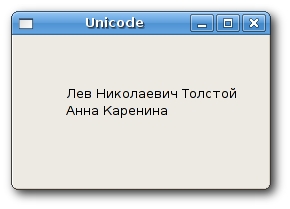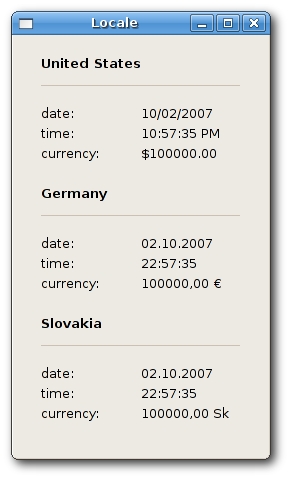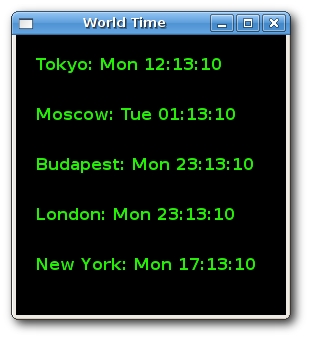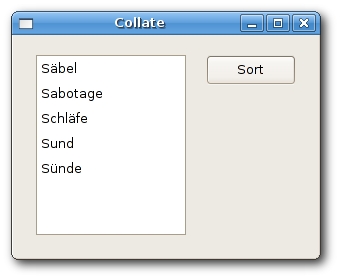Internationalisation
last modified January 10, 2023
In computing, Internationalisation and localisation are means of adapting computer software for non-native environments, especially other nations and cultures. Internationalisation is the process of ensuring that an application is capable of adapting to local requirements, for instance ensuring that the local writing system can be displayed. Localisation is the process of adapting the software to be as familiar as possible to a specific locale, by displaying text in the local language and using local conventions for the display of such things as units of measurement. (wikipedia)
Unicode
There are two builds of wxPython. The ANSI build and the Unicode build. If we want to create and use wxPython applications in languages other than English, we must have the Unicode build.
Unicode is an industry standard allowing computers to consistently represent and manipulate text expressed in any of the world's writing systems. It is a character encoding standard which uses 16 bits for storing characters. The traditional ASCII encoding uses only 8 bits.
First, we need to get the Unicode encoding of Лев Николaевич Толстoй Анна Каренина words.
>>> unicode(u'Лев Николaевич Толстoй Анна Каренина') u'\u041b\u0435\u0432 \u041d\u0438\u043aa\u0430\u0301\u0435\u0432\u0438\u0447 \u0422\u043e\u043b\u0441o\u0439 \u0410\u043d\u043d\u0430 \u041a\u0430\u0440\u0435\u043d\u0438\u043d\u0430'
We launch the Python terminal and use the unicode() function call.
Notice that in the example, we use additional \n\ characters to divide the
words into two lines.
#!/usr/bin/python
import wx
text = u'\u041b\u0435\u0432 \u041d\u0438\u043a\u043e\u043b\u0430\
\u0435\u0432\u0438\u0447 \u0422\u043e\u043b\u0441\u0442\u043e\u0439 \n\
\u0410\u043d\u043d\u0430 \u041a\u0430\u0440\u0435\u043d\u0438\u043d\u0430'
class Unicode(wx.Frame):
def __init__(self, parent, id, title):
wx.Frame.__init__(self, parent, id, title, size=(250, 150))
self.Bind(wx.EVT_PAINT, self.OnPaint)
self.Centre()
self.Show(True)
def OnPaint(self, event):
dc = wx.PaintDC(self)
dc.DrawText(text, 50, 50)
app = wx.App()
Unicode(None, -1, 'Unicode')
app.MainLoop()
In the example, we draw Anna Karenina in russian azbuka on the window.

Locale
A locale is an object that defines user's language, country, number format, letter format, currency format etc. A local variant has the following format.
[language[_territory][.codeset][@modifier]]
For example, de_AT.utf8 is a German local used in Austria, with UTF8 codeset.
#!/usr/bin/python
# locale.py
import wx
import time
import locale
class Locale(wx.Frame):
def __init__(self, parent, id, title):
wx.Frame.__init__(self, parent, id, title, size=(250, 420))
panel = wx.Panel(self, -1)
tm = time.localtime()
font = wx.Font(10, wx.DEFAULT, wx.NORMAL, wx.BOLD)
us = wx.StaticText(self, -1, 'United States', (25, 20))
us.SetFont(font)
wx.StaticLine(self, -1, (25, 50), (200 ,1))
locale.setlocale(locale.LC_ALL, '')
date = time.strftime('%x', tm)
time_ = time.strftime('%X', tm)
curr = locale.currency(100000)
wx.StaticText(self, -1, 'date: ', (25, 70))
wx.StaticText(self, -1, 'time: ', (25, 90))
wx.StaticText(self, -1, 'currency: ', (25, 110))
wx.StaticText(self, -1, str(date), (125, 70))
wx.StaticText(self, -1, str(time_), (125, 90))
wx.StaticText(self, -1, str(curr), (125, 110))
de = wx.StaticText(self, -1, 'Germany', (25, 150))
de.SetFont(font)
wx.StaticLine(self, -1, (25, 180), (200,1))
locale.setlocale(locale.LC_ALL, ('de_DE', 'UTF8'))
date = time.strftime('%x', tm)
time_ = time.strftime('%X', tm)
curr = locale.currency(100000)
wx.StaticText(self, -1, 'date: ', (25, 200))
wx.StaticText(self, -1, 'time: ', (25, 220))
wx.StaticText(self, -1, 'currency: ', (25, 240))
wx.StaticText(self, -1, date, (125, 200))
wx.StaticText(self, -1, time_, (125, 220))
wx.StaticText(self, -1, curr, (125, 240))
de = wx.StaticText(self, -1, 'Slovakia', (25, 280))
de.SetFont(font)
wx.StaticLine(self, -1, (25, 310), (200,1))
locale.setlocale(locale.LC_ALL, ('sk_SK', 'UTF8'))
date = time.strftime('%x', tm)
time_ = time.strftime('%X', tm)
curr = locale.currency(100000)
wx.StaticText(self, -1, 'date: ', (25, 330))
wx.StaticText(self, -1, 'time: ', (25, 350))
wx.StaticText(self, -1, 'currency: ', (25, 370))
wx.StaticText(self, -1, str(date), (125, 330))
wx.StaticText(self, -1, str(time_), (125, 350))
wx.StaticText(self, -1, str(curr), (125, 370))
self.Centre()
self.Show(True)
app = wx.App()
Locale(None, -1, 'Locale')
app.MainLoop()
We use the standard built-in module locale to work with localised settings. In our example, we will show various formats of date, time and currency in the USA, Germany, and Slovakia.
locale.setlocale(locale.LC_ALL, ('de_DE', 'UTF8'))
Here we set a locale object for Germany. LC_ALL is a combination
of all various local settings, e.g. LC_TIME, LC_MONETARY,
and LC_NUMERIC.
date = time.strftime('%x', tm)
time_ = time.strftime('%X', tm)
curr = locale.currency(100000)
These function calls reflect the current locale object.

World Time
At a specific moment, we have different time in countries across the world.
Our globe is divided into time zones. It is not uncommon for programmers
to deal with such tasks. wxPython comes with a wx.DateTime object.
According to the documentation, wxDateTime class represents an absolute
moment in the time.
#!/usr/bin/python
import wx
import time
class WorldTime(wx.Frame):
def __init__(self, parent, id, title):
wx.Frame.__init__(self, parent, id, title, size=(270, 280))
self.panel = wx.Panel(self, -1)
self.panel.SetBackgroundColour('#000000')
font = wx.Font(12, wx.FONTFAMILY_DEFAULT,
wx.FONTSTYLE_NORMAL, wx.FONTWEIGHT_BOLD, False, 'Georgia')
self.dt = wx.DateTime()
self.tokyo = wx.StaticText(self.panel, -1,
self.dt.FormatTime() , (20, 20))
self.tokyo.SetForegroundColour('#23f002')
self.tokyo.SetFont(font)
self.moscow = wx.StaticText(self.panel, -1,
self.dt.FormatTime() , (20, 70))
self.moscow.SetForegroundColour('#23f002')
self.moscow.SetFont(font)
self.budapest = wx.StaticText(self.panel, -1,
self.dt.FormatTime() , (20, 120))
self.budapest.SetForegroundColour('#23f002')
self.budapest.SetFont(font)
self.london = wx.StaticText(self.panel, -1,
self.dt.FormatTime() , (20, 170))
self.london.SetForegroundColour('#23f002')
self.london.SetFont(font)
self.newyork = wx.StaticText(self.panel, -1,
self.dt.FormatTime() , (20, 220))
self.newyork.SetForegroundColour('#23f002')
self.newyork.SetFont(font)
self.OnTimer(None)
self.timer = wx.Timer(self)
self.timer.Start(1000)
self.Bind(wx.EVT_TIMER, self.OnTimer)
self.Centre()
self.Show(True)
def OnTimer(self, evt):
now = self.dt.Now()
self.tokyo.SetLabel('Tokyo: ' + str(now.Format(('%a %T'),
wx.DateTime.GMT_9)))
self.moscow.SetLabel('Moscow: ' + str(now.Format(('%a %T'),
wx.DateTime.MSD)))
self.budapest.SetLabel('Budapest: ' + str(now.Format(('%a %T'),
wx.DateTime.CEST)))
self.london.SetLabel('London: ' + str(now.Format(('%a %T'),
wx.DateTime.WEST)))
self.newyork.SetLabel('New York: ' + str(now.Format(('%a %T'),
wx.DateTime.EDT)))
app = wx.App()
WorldTime(None, -1, 'World Time')
app.MainLoop()
In the code example, we show current time in Tokyo, Moscow, Budapest, London, and New York.
self.dt = wx.DateTime()
Here we create a wx.DateTime object.
now = self.dt.Now()
We get the "absolute moment" in time.
self.tokyo.SetLabel('Tokyo: ' + str(now.Format(('%a %T'),
wx.DateTime.GMT_9)))
This code line sets the time to the appropriate format. The %a
conversion specifier is an abbreviated weekday name according to the current
locale. The %T is the time of day using decimal numbers
using the format %H:%M:%S. The second parameter of the
Format() method specifies the time zone.
GMT_9 is used for Japan, EDT (Eastern Daylight Saving Time) is used in New York etc.
The code example was checked with the timeanddate.com website.

Sorting
Locale settings also affect the way, how strings are being sorted. For example Hungarian language has some characters that are missing in Slovak language or English language. Some languages have accents, others do not.
#!/usr/bin/python
# collate.py
import wx
import locale
ID_SORT = 1
words = [u'Sund', u'S\xe4bel', u'S\xfcnde', u'Schl\xe4fe', u'Sabotage']
class Collate(wx.Frame):
def __init__(self, parent, id, title):
wx.Frame.__init__(self, parent, id, title, size=(300, 220))
panel = wx.Panel(self, -1)
hbox = wx.BoxSizer(wx.HORIZONTAL)
self.listbox = wx.ListBox(panel, -1)
for i in words:
self.listbox.Append(i)
hbox.Add(self.listbox, 1, wx.EXPAND | wx.ALL, 20)
btnPanel = wx.Panel(panel, -1)
vbox = wx.BoxSizer(wx.VERTICAL)
new = wx.Button(btnPanel, ID_SORT, 'Sort', size=(90, 30))
self.Bind(wx.EVT_BUTTON, self.OnSort, id=ID_SORT)
vbox.Add((-1, 20))
vbox.Add(new)
btnPanel.SetSizer(vbox)
hbox.Add(btnPanel, 0.6, wx.EXPAND | wx.RIGHT, 20)
panel.SetSizer(hbox)
locale.setlocale(locale.LC_COLLATE, ('de_DE', 'UTF8'))
self.Centre()
self.Show(True)
def OnSort(self, event):
self.listbox.Clear()
words.sort( lambda a,b: locale.strcoll(a, b) )
for i in words:
self.listbox.Append(i)
app = wx.App()
Collate(None, -1, 'Collate')
app.MainLoop()
In our example, we took 5 germam words from the dictionary.
The default sort() function sorts these words this way:
Sabotage, Schläfe, Sund, Säbel, Sünde. This is incorrect,
because in german alphabet ä character precedes a character.
To get the corect sorting, we must use locale functions.
locale.setlocale(locale.LC_COLLATE, ('de_DE', 'UTF8'))
Here we set the german collate. We could use the LC_ALL option or
the more specific LC_COLLATE one.
words.sort( lambda a,b: locale.strcoll(a, b) )
The trick is to use a new compare function within the sort() function.
We define an anonymous lambda function.
The strcoll() function compares two strings and returns -1, 0, 1
exactly like the default one, but it takes the locale settings (the collate)
into account. This way we have the correct sorting of words.

Simple Translation
In the following example, we will demonstrate a very basic translation.
A programmer has two options. Either to use the GNU gettext or to use the wxPython catalogs. Both systems are compatible.
wxPython has a class wx.Locale, which is a base for using message
catalogs. Each translation has one catalog.
Say, we want to translate a string into German language.
First, we must ensure that we have language support for German language.
$ locale -a C de_AT.utf8 de_BE.utf8 de_CH.utf8 de_DE.utf8 de_LU.utf8 en_AU.utf8 en_BW.utf8 en_CA.utf8 en_DK.utf8 en_GB.utf8 en_HK.utf8 en_IE.utf8 en_IN en_NZ.utf8 en_PH.utf8 en_SG.utf8 en_US.utf8 en_ZA.utf8 en_ZW.utf8 POSIX sk_SK.utf8
To check what languages are supported, we use the locale command.
On my system, I have english, german and slovak language support. English
language and german language have different dialects that is why we have
so many options. Notice the utf8 string. This means that the system uses
utf8 encoding for working with strings.
Next we write our code example. We put the string that are to be
translated into this _(), or we can use the wx.GetTranslation() call.
#!/usr/bin/python
import wx
class Translation(wx.Frame):
def __init__(self, parent, id, title):
wx.Frame.__init__(self, parent, id, title, size=(220, 100))
panel = wx.Panel(self, -1)
mylocale = wx.Locale()
mylocale.AddCatalogLookupPathPrefix('.')
mylocale.AddCatalog('simple_de')
_ = wx.GetTranslation
wx.StaticText(panel, -1, _("hello"), (10, 10))
#wx.StaticText(panel, -1, wx.GetTranslation('hello'), (10, 10))
self.Centre()
self.Show(True)
app = wx.App()
Translation(None, -1, 'Translation')
app.MainLoop()
Next we create a so called PO file. It is a simple text file, which is translators use to translate the strings.
pygettext -o simple_de.po simple.py
To create a po file, we use the pygettext command. To fully understand the format of the po file, consult the gnu gettext manual.
"Content-Type: text/plain; charset=utf-8\n"
We edit the simple_de.po file. We must specify the charset. In our case
it is utf-8.
#: simple.py:17 msgid "hello" msgstr "Grüß Gott"
Here we provide a translation for the hello string.
The last thing we do is to create a binary message catalog.
msgfmt --output-file simple_de.mo simple_de.po
To produce a mo file, we call the msgfmt command.

In this chapter, we have worked with Unicode characters.